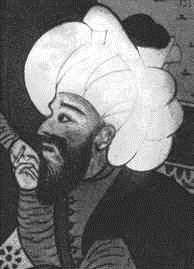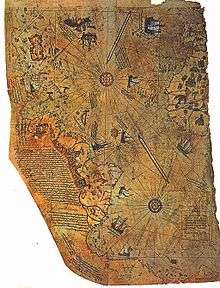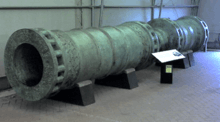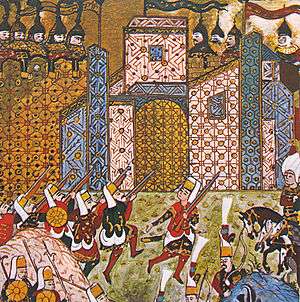Science and technology in the Ottoman Empire

During its 600-year reign, the Ottoman Empire made significant advances in science and technology, in a wide range of fields including mathematics, astronomy and medicine.[1]
The Islamic Golden Age was traditionally believed to have ended in the 14th century,[2] but has been extended to the 15th[3] and 16th[4] centuries by recent scholarship, which has demonstrated that scientific activity continued in the Ottoman Empire in the west and in Persia and Mughal India in the east.
Education
Advancement of Madrasah
The madrasah education institution, which first originated during the Seljuk period, reached its highest point during the Ottoman reign.[5]
Technical Education
Istanbul Technical University has a history that began in 1773. It was founded by Sultan Mustafa III as the Imperial Naval Engineers' School (original name: Mühendishane-i Bahr-i Humayun), and it was originally dedicated to the training of ship builders and cartographers. In 1795 the scope of the school was broadened to train technical military staff to modernize the Ottoman army to match the European standards. In 1845 the engineering department of the school was further developed with the addition of a program devoted to the training of architects. The scope and name of the school were extended and changed again in 1883 and in 1909 the school became a public engineering school which was aimed at training civil engineers who could create new infrastructure to develop the empire.[6]
Sciences
Astronomy
In his Concerning the Supposed Dependence of Astronomy upon Philosophy, Ali Kuşçu (1403–1474) rejected Aristotelian physics and completely separated natural philosophy from Islamic astronomy, allowing astronomy to become a purely empirical and mathematical science. This allowed him to explore alternatives to the Aristotelian notion of a stationery Earth, as he explored the idea of a moving Earth instead. He found empirical evidence for the Earth's rotation through his observation on comets and concluded, on the basis of empiricism rather than speculative philosophy, that the moving Earth theory is just as likely to be true as the stationary Earth theory.[7][8][9]
Kuşçu also improved on Nasīr al-Dīn al-Tūsī's planetary model and presented an alternative planetary model for Mercury.[10]
Taqi al-Din later built the Constantinople Observatory of Taqi ad-Din in 1577, where he carried out astronomical observations until 1580. He produced a Zij (named Unbored Pearl) and astronomical catalogues that were more accurate than those of his contemporaries, Tycho Brahe and Nicolaus Copernicus. Taqi al-Din was also the first astronomer to employ a decimal point notation in his observations rather than the sexagesimal fractions used by his contemporaries and predecessors. He also made use of Abū Rayhān al-Bīrūnī's method of "three points observation". In The Nabk Tree, Taqi al-Din described the three points as "two of them being in opposition in the ecliptic and the third in any desired place." He used this method to calculate the eccentricity of the Sun's orbit and the annual motion of the apogee, and so did Tycho Brahe and Copernicus shortly afterwards, though Taqi al-Din's values were more accurate, due to his observational clock and other more accurate instruments.[11] He also invented a variety of other astronomical instruments, including accurate mechanical astronomical clocks from 1556 to 1580.
After the destruction of the Constantinople observatory of Taqi al-Din in 1580, astronomical activity stagnated in the Ottoman Empire, until the introduction of Copernican heliocentrism in 1660, when the Ottoman scholar Ibrahim Efendi al-Zigetvari Tezkireci translated Noël Duret's French astronomical work (written in 1637) into Arabic.[12]
Geography

The Piri Reis map was discovered in 1929 while Topkapi Palace, Constantinople, Turkey was being converted into a museum. It consists of a map drawn on gazelle skin, primarily detailing the western coast of Africa and the eastern coast of South America. The map is considered to have been drawn in 1513 by Piri Reis, a famous admiral of the Turkish fleet. The Piri Reis map was one of the earliest world maps to include the Americas.[13]
Medicine
Şerafeddin Sabuncuoğlu was the author of the Cerrahiyyetu'l-Haniyye (Imperial Surgery), the first illustrated surgical atlas, and the Mücerrebname (On Attemption). The Cerrahiyyetu'l-Haniyye (Imperial Surgery) was the first surgical atlas and the last major medical encyclopedia from the Islamic world. Though his work was largely based on Abu al-Qasim al-Zahrawi's Al-Tasrif, Sabuncuoğlu introduced many innovations of his own. Female surgeons were also illustrated for the first time in the Cerrahiyyetu'l-Haniyye.[14]
Physics
In 1574, Taqi al-Din (1526–1585) wrote the last major Arabic work on optics, entitled Kitab Nūr hadaqat al-ibsār wa-nūr haqīqat al-anzār (Book of the Light of the Pupil of Vision and the Light of the Truth of the Sights), which contains experimental investigations in three volumes on vision, the light's reflection, and the light's refraction.[15] The book deals with the structure of light, its diffusion and global refraction, and the relation between light and colour. In the first volume, he discusses "the nature of light, the source of light, the nature of the propagation of light, the formation of sight, and the effect of light on the eye and sight". In the second volume, he provides "experimental proof of the specular reflection of accidental as well as essential light, a complete formulation of the laws of reflection, and a description of the construction and use of a copper instrument for measuring reflections from plane, spherical, cylindrical, and conical mirrors, whether convex or concave." The third volume "analyses the important question of the variations light undergoes while traveling in mediums having different densities, i.e. the nature of refracted light, the formation of refraction, the nature of images formed by refracted light."
Taqi al-Din also used astrophysics to explain the intromission model of vision. He stated since the stars are millions of kilometers away from the Earth and that the speed of light is constant, that if light had come from the eye, it would take too long for light "to travel to the star and come back to the eye. But this is not the case, since we see the star as soon as we open our eyes. Therefore the light must emerge from the object not from the eyes."[16]
Mechanical technology
In 1559, Taqi al-Din invented a six-cylinder 'Monobloc' pump. It was a hydropowered water-raising machine incorporating valves, suction and delivery pipes, piston rods with lead weights, trip levers with pin joints, and cams on the axle of a water-driven scoop-wheel.[17] His 'Monobloc' pump could also create a partial vacuum, which was formed "as the lead weight moves upwards, it pulls the piston with it, creating vacuum which sucks the water through a non return clack valve into the piston cylinder."[18]
Mechanical clocks
The Ottoman engineer Taqi al-Din invented a mechanical astronomical clock, capable of striking an alarm at any time specified by the user. He described the clock in his book, The Brightest Stars for the Construction of Mechanical Clocks (Al-Kawākib al-durriyya fī wadh' al-bankāmat al-dawriyya), published in 1559. Similarly to earlier 15th-century European alarm clocks,[19][20] his clock was capable of sounding at a specified time, achieved by placing a peg on the dial wheel. At the requested time, the peg activated a ringing device.[21] This clock had three dials which showed the hours, degrees and minutes.[21]
He later designed an observational clock to aid in observations at his Constantinople Observatory of Taqi ad-Din (1577–1580). In his treatise In The Nabk Tree of the Extremity of Thoughts, he wrote: "We constructed a mechanical clock with three dials which show the hours, the minutes, and the seconds. We divided each minute into five seconds.” This was an important innovation in 16th-century practical astronomy, as at the start of the century clocks were not accurate enough to be used for astronomical purposes.[11]
An example of a watch which measured time in minutes was created by an Ottoman watchmaker, Meshur Sheyh Dede, in 1702.[22]
Steam power
In 1551, Taqi al-Din described an early example of an impulse steam turbine and also noted practical applications for a steam turbine as a prime mover for rotating a spit, predating Giovanni Branca's later impulse steam turbine from 1629. Taqi al-Din described such a device in his book, Al-Turuq al-saniyya fi al-alat al-ruhaniyya (The Sublime Methods of Spiritual Machines), completed in 1551 AD (959 AH).[23] (See Steam jack.)
Ottoman Egyptian industries began moving towards steam power in the early 19th century. In Egypt under Muhammad Ali, industrial manufacturing was initially driven by machinery that relied on traditional energy sources, such as animal power, water wheels, and windmills, which were also the principle energy sources in Western Europe up until around 1870. Under Muhammad Ali of Egypt in the early 19th century, steam engines were introduced to Egyptian industrial manufacturing, with boilers manufactured and installed in industries such as ironworks, textile manufacturing, paper mills, and hulling mills. While there was a lack of coal deposits in Egypt, prospectors searched for coal deposits there, and imported coal from overseas, at similar prices to what imported coal cost in France, until the 1830s, when Egypt gained access to coal sources in Lebanon, which had a yearly coal output of 4,000 tons. Compared to Western Europe, Egypt also had superior agriculture and an efficient transport network through the Nile. Economic historian Jean Batou argues that the necessary economic conditions for rapid industrialization existed in Egypt during the 1820s–1830s, as well as for the adoption of oil as a potential energy source for its steam engines later in the 19th century.[24]
Military


David Nicolle claimed the Janissary corps of the Ottoman army were using matchlock muskets as early as the 1440s.[25]
The chief architect of the Ottoman artillery park in the siege of Constantinople was the Hungarian engineer Orban, who had earlier offered his services to the Byzantine Empire emperor Constantine XI.[26][27]
The marching band and military band both have their origins in the Ottoman military band, performed by the Janissary since the 16th century.[28]
See also
Notes
- ↑ "Ottoman Contributions to Science and Technology | Muslim Heritage". www.muslimheritage.com. Retrieved 2016-11-22.
- ↑ Matthew E. Falagas, Effie A. Zarkadoulia, George Samonis (2006). "Arab science in the golden age (750–1258 C.E.) and today", The FASEB Journal 20: 1581-6
- ↑ George Saliba (1994), A History of Arabic Astronomy: Planetary Theories During the Golden Age of Islam, pp. 245, 250, 256-7, New York University Press, ISBN 0814780237
- ↑ Ahmad Y Hassan, Factors Behind the Decline of Islamic Science After the Sixteenth Century
- ↑ İnalcık, Halil. 1973. "Learning, the Medrese, and the Ulema." In The Ottoman Empire: The Classical Age 1300–1600. New York: Praeger, pp. 165–178.
- ↑ "ITU - History". www.itu.edu.tr. Istanbul Technical University. Retrieved 2016-11-22.
- ↑ (Ragep 2001a)
- ↑ F. Jamil Ragep (2001), "Freeing Astronomy from Philosophy: An Aspect of Islamic Influence on Science", Osiris, 2nd Series, Vol. 16, Science in Theistic Contexts: Cognitive Dimensions, p. 49-64, 66-71.
- ↑ Edith Dudley Sylla, "Creation and nature", in Arthur Stephen McGrade (2003), p. 178-179, Cambridge University Press, ISBN 0521000637.
- ↑ George Saliba, "Arabic planetary theories after the eleventh century AD", in Rushdī Rāshid and Régis Morelon (1996), Encyclopedia of the History of Arabic Science, p. 58-127 [123-124], Routledge, ISBN 0415124107.
- 1 2 Sevim Tekeli, "Taqi al-Din", in Helaine Selin (1997), Encyclopaedia of the History of Science, Technology, and Medicine in Non-Western Cultures, Kluwer Academic Publishers, ISBN 0792340663.
- ↑ Zaken, Avner Ben (2004). "The heavens of the sky and the heavens of the heart: the Ottoman cultural context for the introduction of post-Copernican astronomy". The British Journal for the History of Science. Cambridge University Press. 37: 1–28. doi:10.1017/S0007087403005302.
- ↑ "The Piri Reis Map". www.uwgb.edu. Archived from the original on 31 March 2017. Retrieved 22 November 2016.
- ↑ G. Bademci (2006), "First illustrations of female Neurosurgeons in the fifteenth century by Serefeddin Sabuncuoglu", Neurocirugía 17: 162-5
- ↑ Dr. Salim Ayduz (26 June 2008). "Taqi al-Din Ibn Ma'ruf: A Bio-Bibliographical Essay". Retrieved 2008-07-04. )
- ↑ Topdemir, Hüseyin Gazi (1999). "Takîyüddîn'in Optik Kitabi". Ministry of Culture Press, Ankara. (cf. Dr. Hüseyin Gazi Topdemir (30 June 2008). "Taqi al-Din ibn Ma'ruf and the Science of Optics: The Nature of Light and the Mechanism of Vision". FSTC Limited. Retrieved 2008-07-04. )
- ↑ Donald Routledge Hill, "Engineering", p. 779, in (Rashed & Morelon 1996, pp. 751–95)
- ↑ Salim Al-Hassani (23–25 October 2001). "The Machines of Al-Jazari and Taqi Al-Din". 22nd Annual Conference on the History of Arabic Sciences. Retrieved 2008-07-16.
- ↑ p. 249, The Grove encyclopedia of decorative arts, Gordon Campbell, vol. 1, Oxford University Press, 2006, ISBN 0195189485.
- ↑ "Monastic Alarm Clocks, Italian" Archived 21 November 2008 at the Wayback Machine., entry, Clock Dictionary.
- 1 2 Al-Hassani, Salim (19 June 2008). "The Astronomical Clock of Taqi Al-Din: Virtual Reconstruction". FSTC. Retrieved 2008-07-02.
- ↑ Horton, Paul (1977). "Topkapi's Turkish Timepieces". Saudi Aramco World, July–August 1977: 10–13. Retrieved 2008-07-12.
- ↑ Ahmad Y Hassan (1976), Taqi al-Din and Arabic Mechanical Engineering, p. 34-35. Institute for the History of Arabic Science, University of Aleppo.
- ↑ Jean Batou (1991). Between Development and Underdevelopment: The Precocious Attempts at Industrialization of the Periphery, 1800-1870. Librairie Droz. pp. 193–196.
- ↑ Nicolle, David (1995). The Janissaries. Osprey. p. 22. ISBN 1-85532-413-X.
- ↑ Runciman, Steven (1990). The Fall of Constantinople, 1453. Cambridge University Press. ISBN 9780521398329. , pp.79-80
- ↑ Nicolle, David (2000). Constantinople 1453: The end of Byzantium. Osprey Publishing. ISBN 1-84176-091-9. , p.13{
- ↑ Bowles, Edmund A. (2006). "The impact of Turkish military bands on European court festivals in the 17th and 18th centuries". Early Music. Oxford University Press. 34 (4): 533–60. doi:10.1093/em/cal103.
References
- History of Astronomy Literature during the Ottoman Period by Ekmeleddin İhsanoğlu
Further reading
- Science among the Ottomans: The Cultural Creation and Exchange of Knowledge by Miri Shefer-Mossensohn, 2015, University of Texas Press